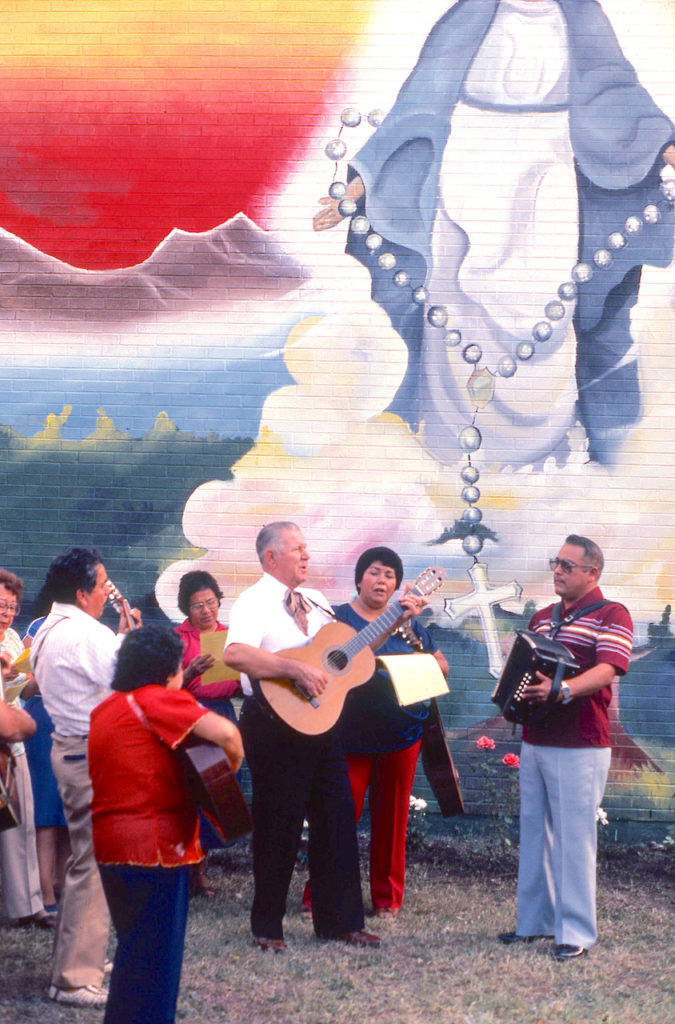The first Chicano murals originated in 1965 on the walls of Cesar Chavez’ United Farm Workers [UFW] union headquarters in Delano, California. A decade later, supporters of Chavez’ UFW union marched from the Texas Rio Grande Valley to Austin with stops in San Antonio. San Antonio artists took notice of the UFW’s use of colorful banners with artwork depicting farm worker issues in addition to the marchers’ incorporation of cultural images such as the Virgin Guadalupe to unite supporters.
Chicano murals first appeared in San Antonio in 1974 when Jesse Trevino completed his monumental mural “La Historia Chicana” at the Student Union Building of Our Lady of the Lake University [OLLC]. Trevino, an art history major at OLLC, studied previously at San Antonio College where he had been influenced by art professor Mel Casas. Located in San Antonio’s Westside, OLLC was in close proximity to the Cassiano Homes near the street intersection of Laredo and Zarzamora.
 By the mid 1970s several Chicano leaders in the art community including art professor Mel Casas and Cesar Martinez, a graduate of Texas A&M Kingsville, were active in promoting the works of San Antonio artists who identified as Mexican American or Chicano. Jesse Trevino knew these artists and had painted a large mural depicting his personal story in his home. His mural, “Mi Vida” gave him the confidence to undertake the OLLC mural which measured 100×57 inches.
By the mid 1970s several Chicano leaders in the art community including art professor Mel Casas and Cesar Martinez, a graduate of Texas A&M Kingsville, were active in promoting the works of San Antonio artists who identified as Mexican American or Chicano. Jesse Trevino knew these artists and had painted a large mural depicting his personal story in his home. His mural, “Mi Vida” gave him the confidence to undertake the OLLC mural which measured 100×57 inches.
The San Antonio mural movement began when Anastacio Torres and Juan Hernandez, both Westsiders and graduates of Lanier High School, approached owners of a retail food store near 24th street and Castroville Road about the possibility of painting the back wall of the store. The property owners agreed on the assumption that the painted wall would beautify the outdoor space.
Torres and Hernandez completed their mural near the Veramendi Public Housing community. The artists painted the wall without ladders and scaffolding standing on their car hoods and on top of their cars to attain the required height of the mural. With a public mural under their belt, they applied for city arts funding and with the small grant formed the Community Arts Organization at the Cassiano Homes. Next, they canvassed the neighborhood asking residents about preferences of artistic subjects, themes, and concepts.
By 1980 the public arts project at Cassiano Homes was well underway. The city arts funding allowed Torres and Hernandez to hire young artists to work on their mural crews, many of whom had little experience in public art. One of the rationales for creating public art concerned the prevalence of graffiti which bothered the majority of Cassiano Homes residents. Alex Rubio, a resident of the nearby San Juan Housing complex, was one of the most active graffiti artists of the Westside. While still a teenager, he established himself as a prolific and creative “tagger,” as graffiti artists were known. Torres and Hernandez were able to locate Rubio and hired him for their mural project.
In the 1980s, nearly all the Chicano murals of the city were located in the Cassiano Homes. With funding from the City of San Antonio, the Community Arts Program completed more than 50 murals. The murals included religious themes, historical events, and notable figures of the Mexican Revolution including Francisco Villa and Emiliano Zapata.
Some of the murals celebrated San Antonio and Texas personalities such as Congressman Henry B. Gonzalez and Bishop Patricio Flores as well as Chicano and Latino musicians. On the barrio walls of Cassiano Homes the muralists painted portrayals of historic events
such as the U.S.-Mexican War and the Treaty of Guadalupe Hidalgo in addition to Mexican icons such as cactus and eagles.
In the late 1980s, funding for the Cassiano Homes dried up and Torres and Hernandez closed the community mural arts headquarters. Two of the artists who participated in the murals project, Vincent Valdez and Alex Rubio, emerged as major Chicano artists. Their mural painting experience helped their development as Chicano artists. Today, they continue making a significant contribution to the Chicano and Latino art movement and both have art works in major museums in San Antonio.
Ricardo Romo






